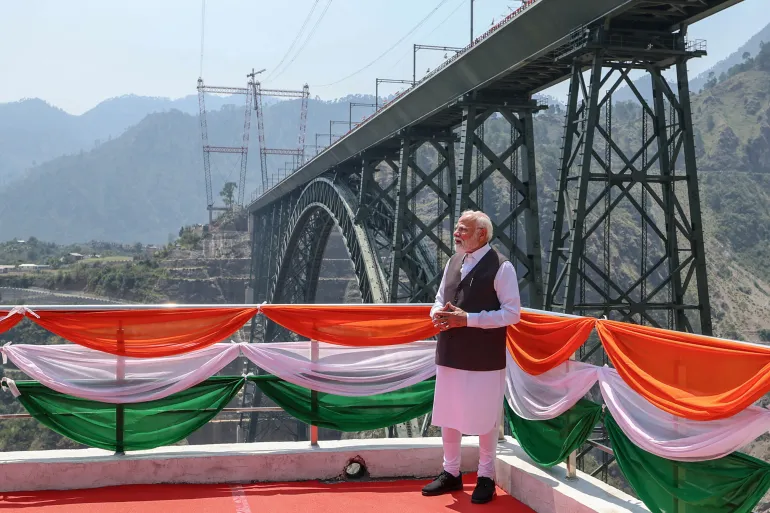The Chenab Bridge stands as a massive achievement in India’s engineering and infrastructure development. It is not just a bridge but a symbol of modernization, connecting remote regions with key economic hubs. Its inauguration by Prime Minister Narendra Modi marks a historic milestone for India’s progress in infrastructure and strategic strength. This new marvel will transform transportation in Jammu and Kashmir, making travel safer, faster, and more reliable. The project reflects India’s ambition to build structures that push the limits of engineering and serve national interests.
The Engineering Marvel of the Chenab Bridge
Structure and Design of the World’s Tallest Single-Arch Railway Bridge
The Chenab Bridge is a spectacular feat of engineering. It stretches about 1,315 meters long and stands 359 meters tall at its highest point, making it the tallest single-arch railway bridge in the world. Its arch spans an impressive 467 meters, supporting the railway track beneath. The bridge’s design resembles a giant, steel bow, grounded in tough Himalayan terrain. High-quality steel and concrete were used to resist extreme weather and seismic activity. The innovative design allows the bridge to handle heavy loads and withstand earthquakes, ensuring safety over decades.
Construction Challenges and Solutions
Building this bridge was no easy task. Engineers faced rugged mountains, strong winds, and the risk of landslides. The construction site was remote, making transportation of materials difficult. Using helicopters and special cranes, teams carefully placed components in hard-to-reach areas. To ensure safety, engineers devised flexible supports that can absorb earthquakes and temperature changes. Unique rock anchors and reinforced steel helped stabilize the structure amid challenging conditions.
Construction Timeline and Key Milestones
The project took nearly a decade from start to finish. Construction began in 2010, with major breakthroughs by 2017. Critical milestones include laying the foundation in tough rock, erecting the arch, and installing tracks. Experts from across India and abroad contributed their skills. The project involved thousands of workers and countless engineers. Each step brought the bridge closer to completion, marking a huge achievement for India’s infrastructure teams.
Strategic and Economic Significance
Boost to Regional Connectivity and Economic Development
The Chenab Bridge dramatically improves links between Kashmir and India’s main cities. It overnight shortens travel times and opens up the region for more trade and tourism. Farmers can now move goods more easily, and visitors will find it simpler to explore Kashmir’s natural beauty. This boost in connectivity promises new jobs and greater local income, helping communities grow. It acts like a bridge in more ways than one—it connects people, places, and opportunities.
Strategic Defense and Security Implications
The bridge has major strategic value. It strengthens India’s defense logistics in a sensitive border region and improves troop mobility. Having reliable transportation routes in the Himalayas means India can respond faster to any security needs. The structure acts as a crucial piece of infrastructure that supports stability in the region. It’s a reminder that modern infrastructure also boosts national security.
Contribution to India’s Infrastructure Growth
The Chenab Bridge aligns with India’s push to modernize its rail network. It demonstrates what Indian engineers can achieve in difficult terrains. The project sets a new standard for future large-scale infrastructure efforts. It shows that India is capable of building world-class structures that can stand tall in challenging environments. Over time, such projects will help India grow into a global leader in engineering.
Environmental and Sustainability Aspects
Environmental Impact of Construction
Constructing in mountain ecosystems posed risks to flora and fauna. Engineers took steps to minimize disturbance. They avoided cutting down trees unnecessarily and carefully managed waste. Special measures protected local wildlife and water sources. The project team balanced progress with environmental sensitivity to preserve the region’s ecological richness.
Focus on Sustainability and Eco-Friendly Practices
The construction used eco-friendly materials that last longer and cause less pollution. Techniques such as recycling concrete waste and reducing energy consumption were employed. Maintenance practices include regular inspections to prevent corrosion. These efforts help ensure the bridge’s long-term sustainability without harming the environment.
Technological Innovations and Future Prospects
Cutting-Edge Engineering and Construction Technologies
Modern tools like seismic sensors and weather-resistant steel made construction safer. Engineers used computer simulations to test the bridge’s stability under different conditions. Lessons learned in the process will help shape future projects in difficult terrains. These innovations allow for safer, more durable infrastructure in challenging locations worldwide.
Potential for Similar Infrastructure Projects
The success of the Chenab Bridge inspires future mega projects. It proves that even the toughest environments can be tackled with the right engineering. Governments and companies can now think bigger and push boundaries in infrastructure. Such work will open new frontiers for connecting remote regions in India and beyond.
Key Quotes, Expert Opinions, and Reactions
Industry experts call the Chenab Bridge a landmark achievement. They praise its design, safety features, and impact on regional growth. Politicians see it as proof that India can build at the highest standards. Narendra Modi described the project as a symbol of India’s engineering spirit and commitment to progress. Public reactions celebrate the bridge as a new hope for Kashmir’s future.
Conclusion
The Chenab Bridge stands as a shining example of engineering excellence and strategic foresight. It links distant mountains to the world, opening doors for economic growth and regional stability. With its innovative design and eco-friendly approach, the bridge shows that India is capable of tackling tough projects with pride. As this marvel helps shape India’s infrastructure future, it reminds us that bold ideas and expert skills can transform landscapes and lives. The Chenab Bridge is not just a structure; it’s a new chapter in India’s journey of growth and resilience.

